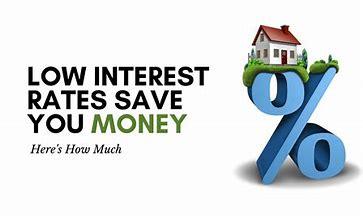
4 minute read
BENEFITS OF LOW INTEREST RATES IN AN ECONOMY
Monetary policy is a demand side policy which influences the aggregate demand of the economy by manipulating money supply and interest rates. This would further stimulate the growth of the economy One way that is mentioned above is manipulating interest rates, which demonstrates if it is more favorable to save or borrow money Interest rate is the price of money borrowed by lenders and reward for savers.

Advertisement
Digging in a little bit deeper, low interest rates are a form of an expansionary monetary policy. This is usually decided by the central bank of a country if they want to imply expansionary or contractionary monetary policy. Expansionary monetary policy is usually implemented when there is slow down in the economy, that may be caused by a recession or other factors influencing this such as high unemployment rate. “The cash rate would need to remain lower for a longer period of time to help the economy recover from the negative shock ” (Chung et al 2019), which means interest rates needs to remain low in order to help the economy recover from a downfall.
There are 2 reasons as to why low interest rates would encourage consumers to borrow more money. Firstly, “Falling interest rates meant banks charged borrowers less for their loans ” (David L ,2020), meaning that the cost of borrowing for consumers/businesses/investors would be cheaper therefore encouraging them to borrow more money. Secondly, when a low interest rate is charged, the return on savings would be lower as opposed to when interest rates are high, thus disincentivizing consumers to save money in the bank Both these reasons above are a way to contribute to stimulating the economic growth of a country
When low interest rates are in motion, this “allows people to spend and invest more freely.” (Maverick., 2021), resulting in a shift in the AD curve from AD1 to AD2. This will increase the average price level from P1 to P2 and an increase in the real output from Y1 to Y2, meaning that there would be a rise in the GDP (Gross Domestic Product) as national income rises which would likely increase economic growth, probably decrease unemployment, and increase exports

Low interest rates can make it less expensive for governments to borrow money which may be used to pay off their debt or fund new infrastructure projects
As new infrastructure would be built in the economy, there would be a higher demand for laborers to cater the building of new infrastructures, this is known as derived demand This would lead to a decrease in unemployment in a country. As a result, making it easier for the government to stay within their budget and not resort to cuts in spending or increasing taxation
In the consumer’s eye, borrowing becomes more attractive when interest rates are low therefore the demand for loans would increase. A lower interest rate would also mean that consumers with mortgages may find their mortgage payments fall These would result in more disposable income for consumers to spend on goods and services, as a result, increasing the aggregate demand in an economy which would lead to an increase in economic growth
For example, “home sales are usually higher when mortgage rates are 5 percent than if they were 10 percad better products may be produced.
Low interest rates can encourage investors to invest in riskier investments and seek higher returns, such as stocks and real estate. This would occur because investors would gain confidence to invest due to the low rates of borrowing. However, these investors would seek to invest the money borrowed in other countries to earn higher return on investment Therefore, leading to a decrease in demand for the currency with low interest rate, causing the currency to devalue relative to other currencies The flip side to this is that, when a country exports more than it imports, a positive trade balance is created.
As the currency of a country depreciates, goods and services will become relatively cheaper for other countries to buy. “This is because the number of products that other countries used to buy will be more in the same amount of money, therefore increasing the export of the country ” The import of the low interest rate country would be more expensive because “the number of products that they used to buy will be lesser in the same amount of money,” due to the weakened exchange rate. As a result, making exports cheaper and imports more expensive, further boosting economic growth.
Bibliography https://www washingtonpost com/b usiness/2020/10/03/low-interestrates/ https://www rba gov au/publicatio ns/bulletin/2020/sep/the-economiceffects-of-low-interest-rates-andunconventional-monetarypolicy html https://www.investopedia.com/ask/ answers/071715/how-do-changesinterest-rates-affect-spendinghabits-economy.asp https://www stlouisfed org/publicat ions/regional-economist/october2010/low-interest-rates-havebenefits https://www finnomena com/zadmin/currency-appreciationdepreciation/


Market failure is a fundamental concept in microeconomics that describes the situation where resource allocation is inefficient in a free market. In an idealized functioning free market, the relationship between supply and demand should be in balance However, when this supply-demand balance is disrupted, market failure occurs. (Team, T.I. 2023) There are many common reasons for market failure, including externalities, information asymmetry, public goods, and monopolies In this article, I will focus on theoretical knowledge about externalities and real-life practical examples.
Externalities can be classified as positive or negative, and they occur when the production of a good or service affects a third party (People or groups who are not directly involved in any economic activity but are affected by externalities) in a beneficial or harmful way. Positive externalities refer to economic activities that benefit third parties without the actor receiving any benefits themselves To illustrate, consider the example of Producer A, whose apple orchard benefits a nearby bee farm, which is a positive externality. In contrast, negative externalities refer to economic activities that cause harm to third parties, and the actor responsible does not bear the cost of that harm. Producer B's farmland is negatively affected by the pollution from a chemical plant upstream, which is a negative externality (君⼦终⽇乾乾, 2022)










